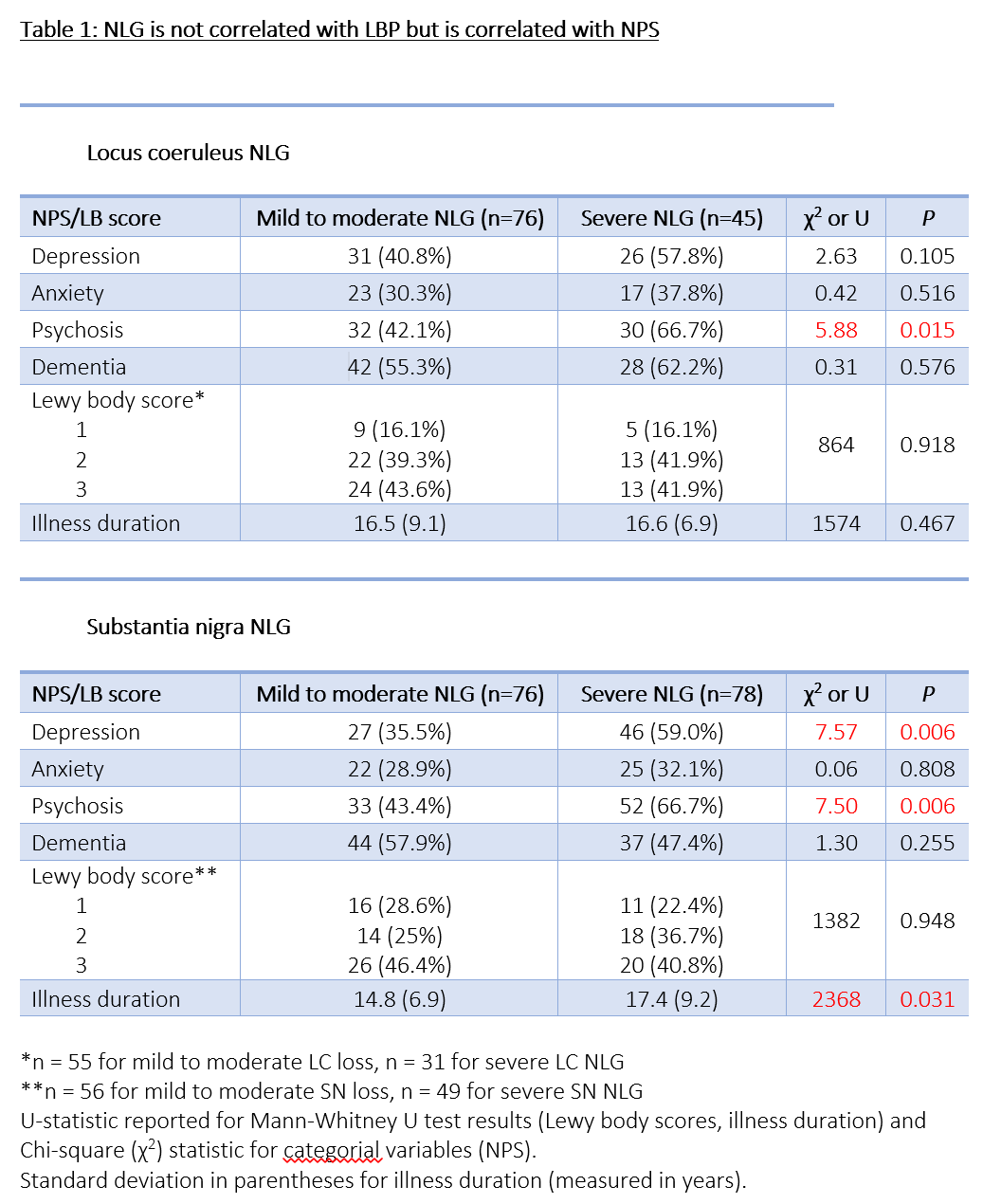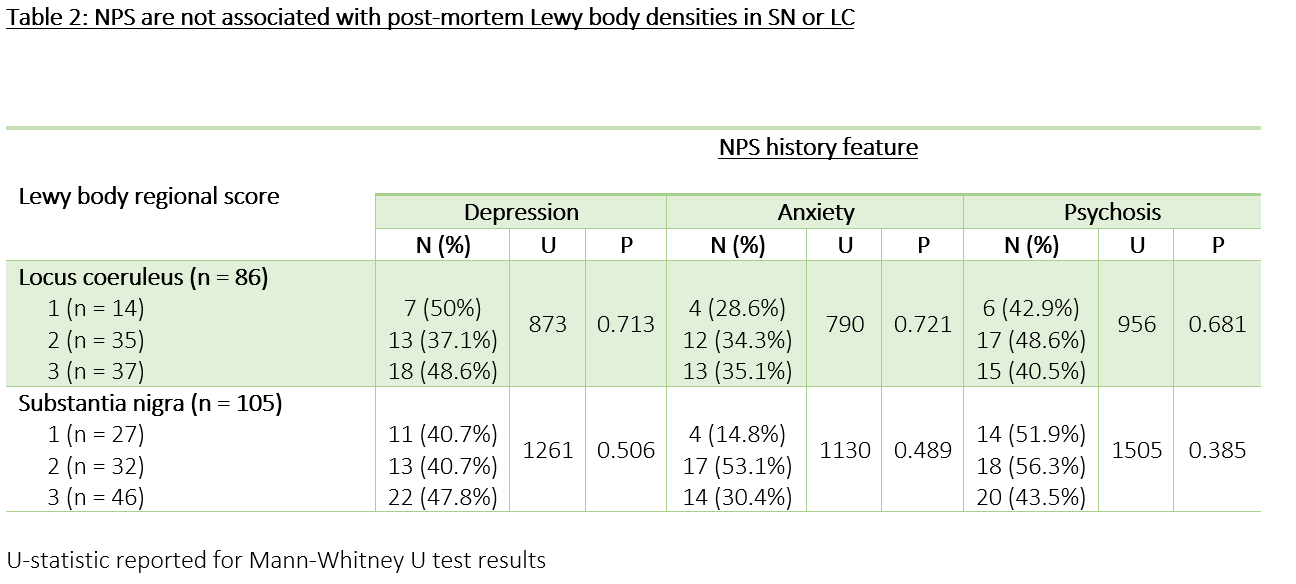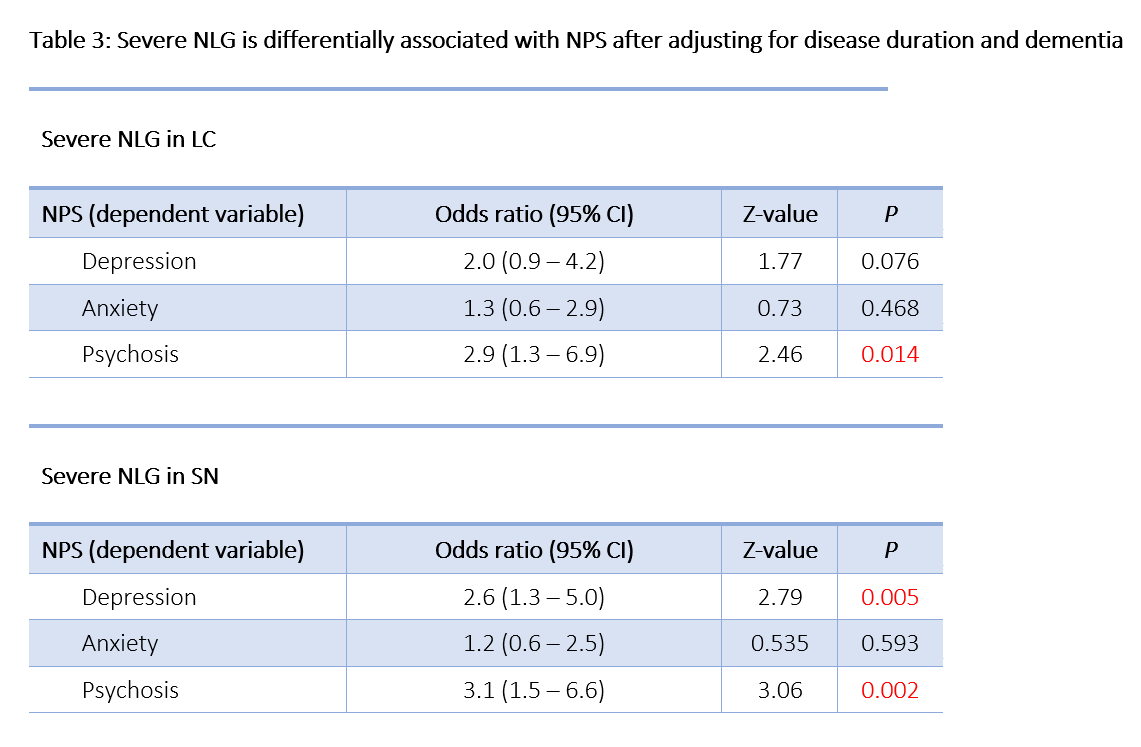Session Information
Date: Monday, October 8, 2018
Session Title: Parkinson's Disease: Psychiatric Manifestations
Session Time: 1:15pm-2:45pm
Location: Hall 3FG
Objective: To test the hypothesis that neuropsychiatric symptoms (NPS) in PD are associated with histopathologically confirmed neuronal loss and gliosis (NLG) in the locus coeruleus (LC) and substantia nigra (SN).
Background: PD motor signs are etiologically linked to SN neurodegeneration and cell loss in the LC may comprise an important step in PD progression (Weinshenker, 2018).
Methods: Autopsy data from 195 participants enrolled for brain-banking in the Morris K. Udall Parkinson’s Disease Research Center were evaluated. We included only data from 176 participants with pathology-confirmed primary diagnosis of PD (19 excluded). Brains were semiquantitatively evaluated for NLG (“severe” or “mild to moderate”) and Lewy body pathology (LBP) (range 1-3). These data were available in the SN and LC in 154 and 121 participants, respectively. Lifetime histories of psychosis, depression, and anxiety were determined through chart extraction or records of formal psychiatric DSM-IV-TR evaluation.
Results: Participants with a history of psychosis more frequently had severe NLG in the LC (χ2=5.9, P=0.02) and SN (χ2=7.5, P=0.006) [table1]. Depression was associated with severe NLG in the SN (χ2=7.6, P=0.006) but not LC. Anxiety was not associated with severe NLG in either region. Notably, none of these three NPS were associated with LBP score in either the SN or LC; furthermore, NLG severity did not correlate with LBP [table2]. Multivariable regression was used to control for disease duration and dementia [table3]. Psychosis remained significantly associated with severe NLG in either the SN (Z=3.1, P=0.002) or LC (Z=2.5, P=0.014). Depression remained significantly associated with severe NLG in SN (Z=2.8, P=0.005).
Conclusions: We leveraged a large autopsy dataset to show that post-mortem NLG in the SN and LC is differentially associated with NPS history in PD. Importantly, multivariable regression suggests that NLG was not simply a proxy for disease duration and that dementia did not confound results. Although LBP in amygdala has been linked to psychosis (Harding et al., 2002), NLG is a more direct metric for cell loss—indeed, LBP may in fact decline with cell loss and debris clearing. Although NPS in PD likely originate from aberrancies in many neurotransmitter systems, our results indicate that NLG in both the norepinephrinergic LC and dopaminergic SN can be specifically linked histories of NPS.
References: Harding AJ, Broe GA, Halliday GM. Visual hallucinations in Lewy body disease relate to Lewy bodies in the temporal lobe. Brain 2002; 125: 391–403. Weinshenker D. Long Road to Ruin: Noradrenergic Dysfunction in Neurodegenerative Disease. Trends Neurosci. 2018; Article in press.
To cite this abstract in AMA style:
J. Hinkle, N. Fischer, K. Perepezko, C. Bakker, M. Broen, A. Butala, T. Dawson, A. Leentjens, Z. Mari, C. Marvel, K. Mills, E. Moukheiber, A. Pantelyat, O. Pletniková, L. Rosenthal, M. Shepard, J. Troncoso, J. Wang, G. Pontone. Neuropathological correlates of psychiatric disorders in PD [abstract]. Mov Disord. 2018; 33 (suppl 2). https://www.mdsabstracts.org/abstract/neuropathological-correlates-of-psychiatric-disorders-in-pd/. Accessed December 16, 2025.« Back to 2018 International Congress
MDS Abstracts - https://www.mdsabstracts.org/abstract/neuropathological-correlates-of-psychiatric-disorders-in-pd/



